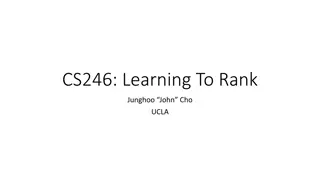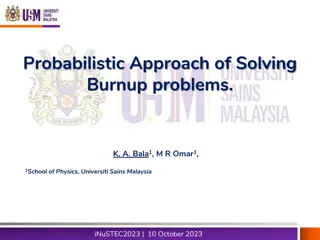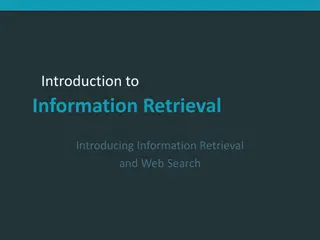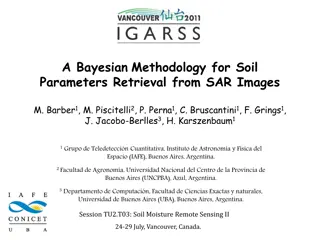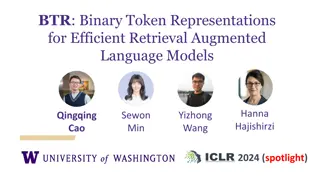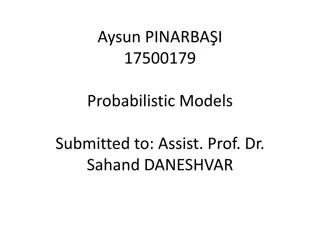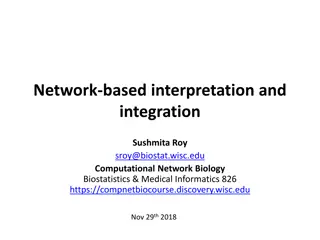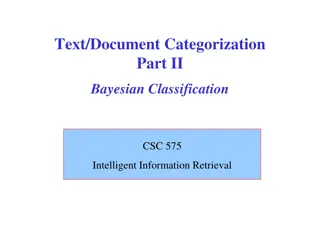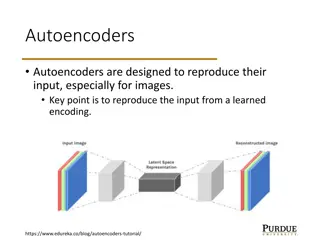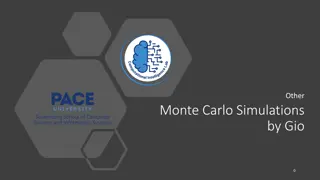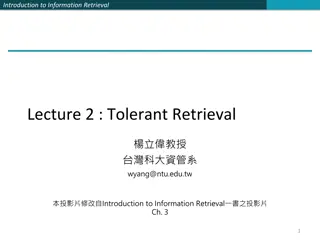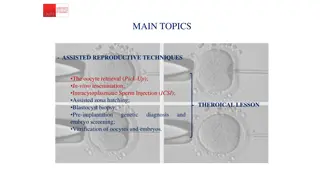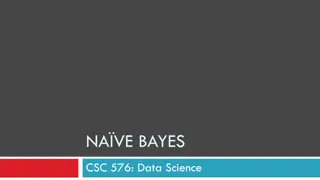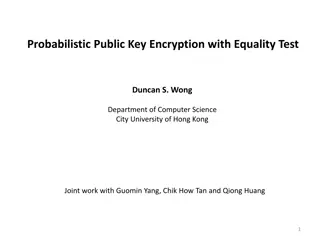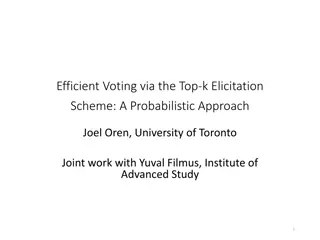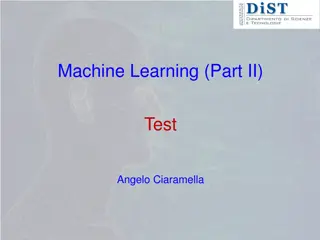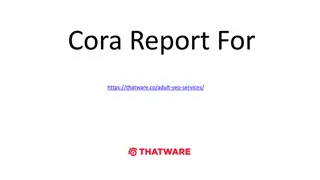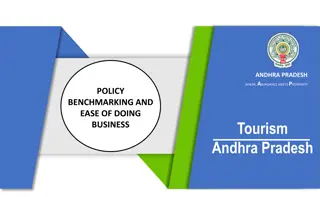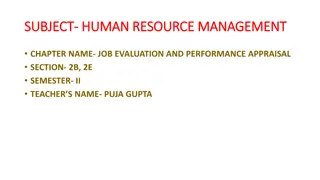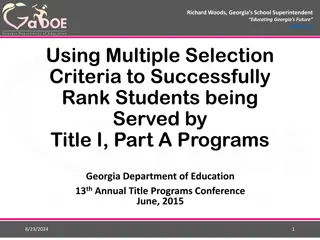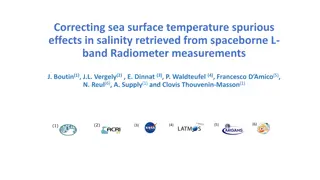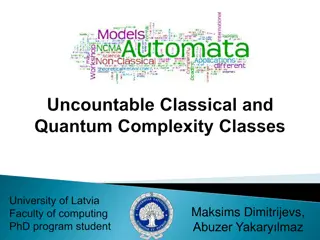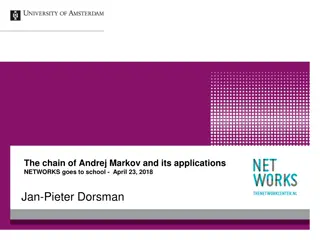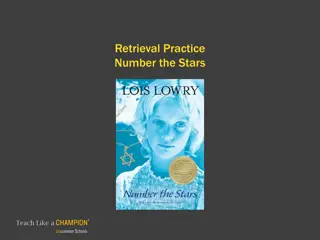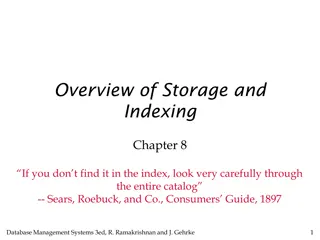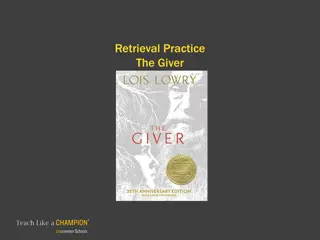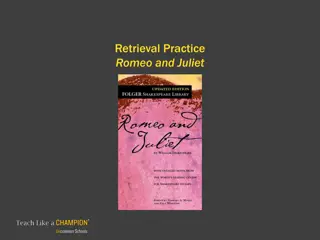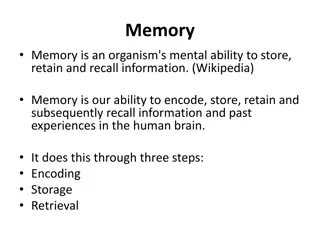Understanding Probabilistic Retrieval Models and Ranking Principles
In CS 589 Fall 2020, topics covered include probabilistic retrieval models, probability ranking principles, and rescaling methods like IDF and pivoted length normalization. The lecture also delves into random variables, Bayes rules, and maximum likelihood estimation. Quiz questions explore document ranking using the Vector Space model.
- Probabilistic Retrieval
- Ranking Principles
- Vector Space Model
- Probability Models
- Information Retrieval
Download Presentation

Please find below an Image/Link to download the presentation.
The content on the website is provided AS IS for your information and personal use only. It may not be sold, licensed, or shared on other websites without obtaining consent from the author. Download presentation by click this link. If you encounter any issues during the download, it is possible that the publisher has removed the file from their server.
E N D
Presentation Transcript
CS 589 Fall 2020 Probability ranking principle Probabilistic retrieval models Instructor: Susan Liu TA: Huihui Liu Stevens Institute of Technology 1
Piazza Only 2 students had enrolled in Piazza Therefore, I have to state our requirement again Outside of OH, if you choose to use email, your question will be answered significantly slower, email: 2 days 2
Recap of last lecture The boolean retrieval system Vector-space model TF: representing documents/queries with a term-document matrix Rescaling methods: IDF: penalizing words which appears everywhere Term frequency rescaling (logarithmic, max normalization) Pivoted length normalization 3
Question from last lecture Between the two term-frequency rescaling methods, which one works better? Max normalization or logarithmic? Max TF normalization Max TF is unstable: max TF in a document vary with change of stop words set When max TF in document d is an outlier, the normalization is incomparable with other documents Does not work well with documents with different TF distribution 4
Todays lecture Basic statistics knowledge Random variables, Bayes rules, maximum likelihood estimation Probabilistic ranking principle Probability retrieval models Robertson & Spark Jones model (RSJ model) BM25 model Language model based retrieval model 5
Quiz from last lecture Suppose we have one query and two documents: q = covid 19 doc1 = covid patient doc2 = 19 99 car wash doc3 = 19 street covid testing facility is reopened next week What are the rankings of score(q, doc) using VS model (w/o IDF)? A. doc1 > doc2 > doc3 B. doc1 = doc3 > doc2 C. doc1 > doc3 > doc2 D. doc3 > doc1 > doc2 6
Answer Recall the VS model: q = covid 19 doc1 = covid patient doc2 = 19 99 car wash doc3 = 19 street covid testing facility is reopen next week score(q, doc1) = 1/sqrt(2)/sqrt(2) = 0.4999, score(q, doc2) = 1/sqrt(2)/sqrt(4) = 0.3535, score(q, doc3) = 2/sqrt(2)/sqrt(9) = 0.4714 Therefore the answer is C: doc1 > doc3 > doc2 7
Random variables Random variables sequence = 0, 1, 0, 0, 1, 1, 0, 1, 0, 1, 0, 0 Observation parameter Bernoulli distribution Maximum likelihood estimation 8
Maximum likelihood estimation Fitting a distribution model to the data Assumes mouse weights follow an underlying distribution 9
Maximum likelihood estimation Fitting a distribution to the data Distributions of mouse weights Applications Making estimations for probabilities for future events to happen For example, predicting the probability for a document to be relevant to a query, and rank all documents by their estimated relevance score 10
Random variables in information retrieval query = artificial intelligence rel = 0, 1, 0, 0, 0, 0, 0, 0 d = artificial, intelligence, machine, intelligence, information, retrieval q = artificial, intelligence Observation Notations: in future slides, q denotes the query, d denotes the 11 document, rel denotes the relevance judgment
Probabilistic graphical model (underlying distribution) seq parameter distribution parameter Bernoulli Multinomial-Dirichlet, 2-Poisson, etc. maximum likelihood estimation maximum a posterior estimation estimation 13
Bayes rules Chain rule: joint distribution Bayes rule: posterior likelihood prior skipping estimating 14 trick for estimating the posterior
Probability ranking principle Assume documents are labelled by 0/1 labels (i.e., the relevance judgement is either 0 or 1), given query q, documents should be ranked on their probabilities of relevance (van Rijsbergen 1979): PRP: rank documents by Theorem. The PRP is optimal, in the sense that it minimizes the expected loss(Ripley 1996) Notations: in future slides, q denotes the query, d denotes the document, rel denotes the relevance judgment 15
Estimating Problems with this estimation? 1. not enough data generative model 2. cannot adapt to new q generative model 16 discriminative model
Estimating Problems with this estimation Difference in absolute probability of relevance odds agree on the relative order 17
Estimating the generative model i.i.d assumption 18
RSJ model (Robertson & Sparck Jones 76) Probability for a word to appear in a relevant doc Probability for a word to appear in a non-relevant doc 19
RSJ model: Summary Uses only binary word occurrence (binary inference model), does not leverage TF information RSJ model was designed for retrieving short text and abstract! Requires relevance judgment No-relevance judgment version: [Croft & Harper 79] Performance is not as good as tuned vector-space model How to improve RSJ based on these desiderata? 20
Desiderata of retrieval models Recall the desiderata of a retrieval models: The importance of TF is sub-linear Penalizing term with large document frequency using IDF Pivot length normalization How to improve RSJ based on these desiderata? 21
Okapi/BM25 Estimate probability using eliteness What is eliteness? A term/word is elite if the document is about the concept denoted by the term Eliteness is binary Term occurrence depends on eliteness eliteness 22
Okapi/BM25 Introduced in 1994 SOTA non-learning retrieval model eliteness (2 Poisson model) 23
Okapi/BM25 We do not know Can we estimate ? Difficulty to estimate Designing a parameter-free model such that it simulates 24
Simulating the 2-Poisson model 25 slides from Stanford CS276 Information retrieval
Analysis of BM25 formulation IDF Pivoted document length normalization 26
Multi-field retrieval title question 27
BM25F Each variable is estimated as the weighted sum of its field value parameter estimation using grid search 28
Multi-field retrieval BM25 outperforms TF-IDF in every field & combined 29
Analysis on the n-Poisson model Advantage: BM25 is based on the 2-Poisson model eliteness: d satisfies q s information need, when q is a single term Disadvantages: For single term, documents will not fall cleanly into elite/non-elite set For multiple term, requires a combinatorial explosion of elite set Requires explicit indexing of the elite words 30
Language model-based retrieval A language model-based retrieval method [Ponte and Croft, 1998] Bernoulli -> multinomial corpus unigram LM 31
Language model-based retrieval Disclaimer: the right figure is a schematic model, not a 32 rigorous graphical model
Language model-based retrieval . . . constant 33 efficient to compute, general formulation
Different senses of model [Ponte and Croft, 98] First sense (high level): an abstraction of the retrieval task itself + decouple retrieval model other problems (e.g., indexing) Second sense (mid level): modeling the distribution, e.g., 2-Poisson model Thirds sense (low level): which statistical language model is used in 34 RSJ model without relevance judgment
Statistical language model A probability distribution over word sequences p( Today is Wednesday ) 0.001 p( Today Wednesday is ) 0.0000000000001 p( The eigenvalue is positive ) 0.00001 Unigram language model Generate text by generating each word INDEPENDENTLY Thus, p(w1 w2 ... wn)=p(w1)p(w2) p(wn) Parameters: {p(ti)} p(t1)+ +p(tN)=1 (N is voc. size) 35
Notes on language model-based retrieval Advantages: Avoided the disadvantages in eliteness Defines a general framework, more accurate can further improve the model In some cases, has outperformed BM25 Disadvantages: The assumed equivalence between query and document is unrealistic Only studied unigram language model Performance is not always good 36
Equivalence to KL-divergence retrieval model KL divergence . . . constant smoothed why not the opposite? (Eq. 1) 37 Notes on the KL-divergence retrieval formula and Dirichlet prior smoothing
Estimating Estimating based on the maximum likelihood estimation Disadvantage: if the word is unseen, probability will be 0 Solution: language model smoothing: (plug in Eq. 1) Dirichlet smoothing 38
Estimating Dirichlet smoothing Jelinek-Mercer smoothing 39
Other smoothing methods Additive smoothing Good-Turing smoothing Absolute discounting Kneser-ney smoothing 40
Tuning parameters in smoothing models [Zhai and Lafferty 02] Tuning parameter using leave-one-out method remove Estimating parameter using Newton s method (2nd derivative) 41 Two-stage language models for information retrieval
Tuning parameters in smoothing models [Zhai and Lafferty 02] Tuning parameter using MLE for the query probability EM algorithm: 42 Two-stage language models for information retrieval
Feedback language model [Zhai and Lafferty 01] 43 Model-based feedback in the language modeling approach to information retrieval
Feedback language model [Zhai and Lafferty 01] sparsity get document model retrieve 44 infer w/ EM algo Model-based feedback in the language modeling approach to information retrieval
Evaluation on smoothing methods [Zhai & Lafferty 02] 45 Two-stage language models for information retrieval
Comparison between BM25 and LM [Bennett et al. 2008] However, BM25 outperforms LM in other cases 47 A Comparative Study of Probabilistic and Language Models for Information Retrieval
Summary on parameter tuning RSJ: no parameter BM25: Due to the formulation of two-Poisson, parameters are difficult to estimate, so use a parameter free version to replace it Language model Leave-one-out EM algorithm 48
Translation-based language model [Xue et al. 2008] The retrieval model can benefit from incorporating knowledge in the formulation Translation matrix: 49 Retrieval Models for Question and Answer Archives
Discussion on query length What if the query is very long? For example, the query is a paragraph or a document The problem of retrieval is turned into a matching problem i.e., semantic matching 52




